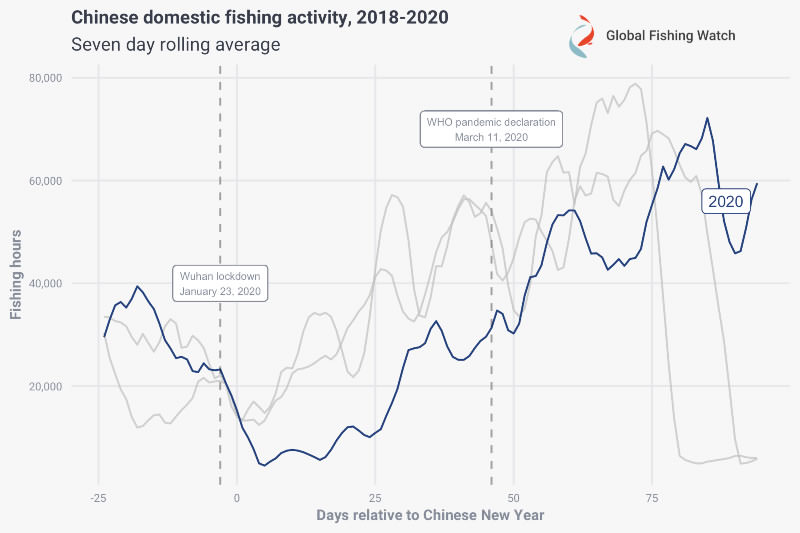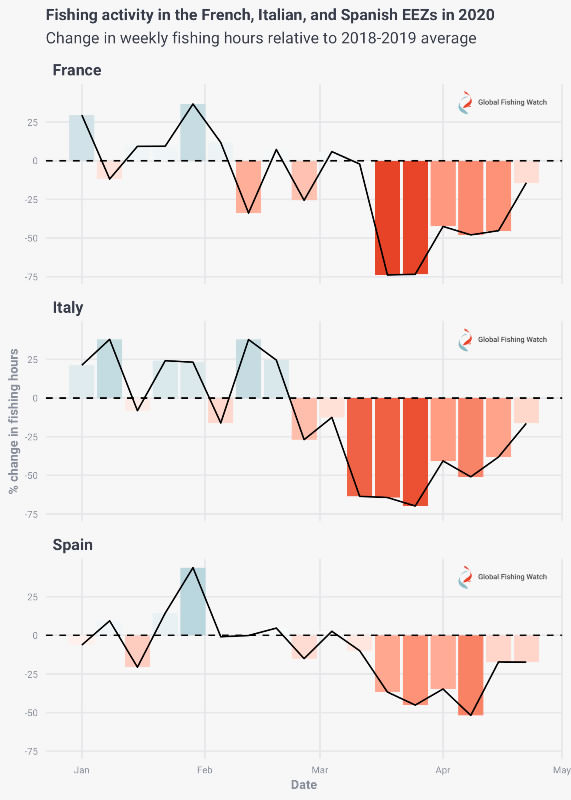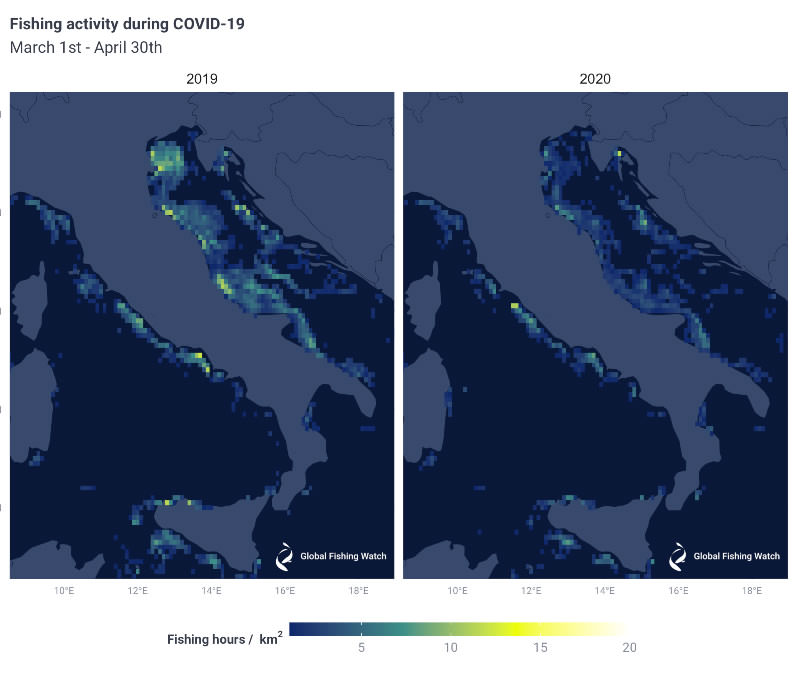This blog post is the first in a series that we will be releasing on the effects of COVID-19 on global fishing activity.
The world is currently experiencing a pandemic due to the novel coronavirus, COVID-19, and the impacts are being felt in nearly all aspects of life. As countries around the world issue stay-at-home orders and everyday life grinds to a halt, the consequences have been wide ranging and substantial, and the fisheries sector is no exception.
According to the Global Fishing Watch database of fishing activity based on AIS data, relative to the previous two year average (2018-2019), global fishing activity is down approximately 6.5% year-to-date (as of 04/28/2020) and nearly 10% since the World Health Organization (WHO) declared COVID-19 a pandemic on March 11th (Figure 1). Importantly, these figures primarily represent changes in activity for the world’s industrial fleet – fishing vessels over 24 meters – and do not fully capture the impacts on small-scale fisheries.

Figure 1: Global fishing activity (hours) through April 28th, 2020 relative to the previous two year average, displayed for the periods before and after the March 11th WHO declaration of the COVID-19 pandemic.
Analysis of global fishing trends requires careful consideration of China, as Chinese vessels represent the majority of all known fishing vessels in our database and account for roughly 20% of global catch each year. The Chinese fishing fleet follows a relatively predictable pattern each year. During four months in the summer, most fishing is prohibited. This moratorium is how China limits its fishing activity to encourage stocks to rebuild. After the moratorium lifts in August and September, fishing initially surges and then gradually decreases until it ceases almost entirely for a few days during the Chinese New Year, which is on a slightly different date each year depending on the lunar calendar. Then fishing gradually increases until it drops again during the moratorium. Thus, the origin – and timing – of COVID-19 in China is significant.
China’s Wuhan lockdown this year coincided with the Chinese New Year at the end of January. The lead up to the New Year looked like any previous year, with fishing activity in China’s Exclusive Economic Zone (EEZ) decreasing to almost zero. But then, it stayed at almost zero for several weeks, as China dramatically restricted movement (Figure 2).

Figure 2: Fishing activity in the Chinese EEZ relative to Chinese New Year, which occurred on January 25th, 2020. Fishing activity for 2018-2020 is plotted relative to the date of Chinese New Year in each year, with 2020 highlighted. Note: the steep drops seen in previous years correspond with the start of the annual moratorium.
By mid-March, shortly after the WHO pandemic declaration, Chinese fishing activity had recovered to a level comparable with previous years before dipping again briefly. As of early April, cumulative fishing activity in China’s EEZ was down nearly 40% since the Chinese New Year, with approximately 1.2 million fewer fishing hours. Unfortunately, as Chinese fleets returned to normalcy, the impacts of COVID-19 spread to fisheries in the rest of the world. Some of the world’s largest fishing nations are now experiencing considerable reductions in year-to-date fishing activity. In Europe, one of the regions hit hardest by COVID-19, many countries are seeing sustained reductions in weekly fishing activity of 50% or more relative to recent years (Figure 3).

Figure 3: Weekly percent change in fishing activity (hours) by domestic fleets in the Spanish, Italian, and French EEZs relative to the previous two-year average for the same week.
Declines in fishing activity are resulting from low demand, falling prices, and seafood market closures. While traditional channels like fresh fish markets and restaurants remain closed, many fishers are resorting to direct sales, though these efforts are likely hampered in many places by stay-at-home orders. In Italy, where a nationwide lockdown has been in effect since March 9th, the decrease in fishing activity is very apparent, particularly in the northern Adriatic (Figure 4).

Figure 4: Comparison of fishing activity off the Italian coast and northern Adriatic between March 1st and April 30th in 2019 (left) and 2020 (right).
Furthermore, captains may be concerned about crew safety, especially on smaller vessels, or unable to access necessary port services, such as buying fuel and bait, due to restrictions and closures. As a result, many vessels are staying longer in port or out at sea. Transshipment – where catch is transferred between vessels – also presents safety risks but may be necessary if vessels remain at sea for longer periods. In some cases, such as suspending observer programs, well intentioned responses to COVID-19 may risk increased IUU activity if the right support policies are not in place. In subsequent posts, we will explore some of these issues in more depth and continue tracking the impact of COVID-19 on global fisheries.
Helpful links
- How is COVID-19 affecting the fisheries and aquaculture food systems – FAO
- Impact of COVID-19 on Mediterranean Fisheries – WWF
Tyler Clavelle is a data scientist at Global Fishing Watch.
